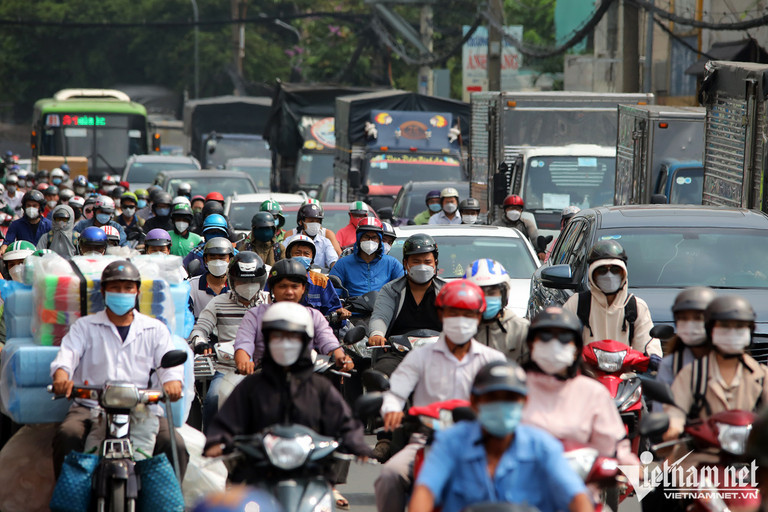
There are 13 million residents in HCM City and the figure increases by 200,000 each year. And there are nearly 9 million vehicles, including 90,000 cars and 8 million motorbikes. About 1,000 vehicles are registered daily.
Meanwhile, the area for bridges and roads has not increased significantly. The ratio of traffic land to urban construction land is only 13.3 percent. The total length of the roads is more than 4,700 kilometers and the density is 2.38km/km2, only 1/5 of the required standard.
French architects in the past planned Sai Gon for about 500,000 residents. Before 1975, Doxiadis Associates from Greece designed a city for 2.4 million people, but the workload was not fully implemented.
Since 1975, the population in HCM City has been increasing, causing overload to transport infrastructure. The municipal authorities have carried out many infrastructure development projects, but the efforts are not enough to satisfy demand.
Traffic jams still occur regularly, thus depriving the city of development opportunities, hindering the exploitation of resources, causing higher budget spending, and affecting investment attraction.
Under city planning to 2020, some large construction projects have been built, such as the East-West Boulevard, Hanoi Boulevard, Nguyen Huu Tho Road, the route of Tan Son Nhat – Binh Loi – outer belt road, Thu Thiem, Phu My, Rach Chiec and Binh Trieu 2 Bridges, and Nguyen Van Cu and Nguyen Tri Phuong roads.
But many other projects have not been implemented, including the five elevated routes, ring road closing, East-North radial axis, port relocation, the renovation and upgrading of nearly 100 intersections, and dozens of parking lot projects.
Most recently, the HCMC Transport Department submitted a plan on developing 10 transport projects, including Nguyen Khoai and Can Gio Bridges, Belt road No 2, Nguyen Thi Dinh and Vinh Loc routes.
The agency emphasized that the key projects were planned many years ago, but they still have not been implemented because of limited resources.
Project capital increases
Experts said that municipal authorities need to learn a lesson from projects whose real investment capital is much higher than initially estimated or take a long time to implement.
In 2012, Subway No 1 (Ben Thanh – Suoi Tien) kicked off with estimated capital of $1.1 billion. But the capital was later pushed up to $3 billion and to date, still cannot be put into operation.
Initially, the city estimated that the six subway routes would cost $3 billion. But later, the capital for developing the six routes and the additional three ground tram lines was reported as $25.8 billion.
When the municipal authorities proposed the expansion of Highway 13, they estimated that the total investment capital was VND4 trillion, including VND2.5 trillion for site clearance. But the required capital has been raised to VND10 trillion, of which VND8.176 trillion will be spent for site clearance.
After analyzing the investment efficiency, experts have come to the conclusion that the later the investment is made and the longer the execution period, the more capital will be needed.
The tardiness in transport project implementation is a reason behind increased traffic congestion. Some congestion points have been settled, but new spots have turned up.
After building the overpass at Nguyen Kiem cross-road, the traffic flow towards the airport has increased rapidly and it is necessary to build the Truong Son overpass. After expanding Le Trong Tan road, traffic jams appear at Truong Chinh cross-roads.
In many cases, investment will be more effective if applying another investment mode. For example, the building of roads in the Sala urban area and the bridge over Kim Cuong Island, capitalized at VND500 billion, that connects with the central area should have been seen as the responsibility of the investor, rather than the city’s budget.
Meanwhile, there is no independent supervisor during the process of proposing and approving projects between governing bodies and dependent units.
In most cases, the finalized investment capital is much higher than initially estimated, thus putting a heavy burden on the state budget.
Tran Van Tuong